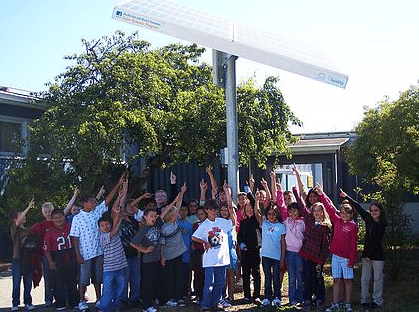The Solar Foundation estimates that more than 3,700 K-12 schools in the U.S. currently have solar power systems on site, serving nearly 2.7 million students across the nation and saving nearly $78 million in electricity costs annually.
While that sounds like cause for celebration, there are currently 50 million students enrolled in elementary or secondary schools in the U.S., and 2.7 million represents only 5 percent of all public school students. When it comes to transitioning our schools to cleaner, healthier renewable energy, there’s still a lot of room for growth.
How does a school go about the complicated process of going solar? With so much competing for district budgets today, how can a school even begin to consider an expenditure on solar when so many other needs are going unmet?
At the recent Clean Energy for Education Symposium at California State University, educators and energy experts met to consider these questions and learn from each other about the rules of the solar road for schools and universities. Panelists from several schools reported they are already generating millions of dollars for their district’s general fund from on-site solar systems.
Here’s some of their advice:
- Make solar part of your school’s or district’s facility master plan. It will be easier to get solar projects approved if they’re part of your overall facility strategy, particularly if that strategy includes an energy management plan.
- Share others’ success. Solar is by nature a collaborative process. Energy Consultant Russell Driver recommends getting buy-in for your solar project by showing district and school colleagues what other districts have achieved with solar. The National Solar Schools Consortium has lots of great resources including a fascinating map showing schools that currently have solar or could benefit from solar and this video of kids explaining solar to grownups. You can also get an idea of the potential savings for solar at a sampling of schools nationwide on the The Solar Foundation web site.
- Let new technologies drive the conversation. LED lighting has been a huge driver for school energy upgrades, returning immediate and in some cases huge savings to schools that makes future energy improvements more palatable.
- Know how to pay for it. No longer do schools have to go through lengthy bond elections to get the financing they need for energy improvements like solar. With power purchase agreements, schools can lock in low electricity rates with little or no upfront costs and after a prearranged term can often buy the systems out for the equivalent of about 50 percent less than their rate of electricity, said Lance Holman of Holman Capital. If your district prefers to own its capital assets, low-interest loans are available through tax-credit or tax-exempt financing, some of which are specially designed for schools in lower income neighborhoods.
- Include education as a cornerstone of your energy plan. Kids are inherently curious about solar energy, and many solar providers include curriculum as part of their offering when working with schools. The SunPower Horizons program is one example of a STEM-focused program that sparks curiosity in science and technology by teaching hands-on engineering concepts.
How to Get Started
The first step in deciding if your school is a good candidate for solar is to gather some basic information – the site address, direction of the roof, and utility bills if you can get them. Then gather a few case studies of other schools that have gone solar. If you need help navigating the process, contact us. We’re here to help!





